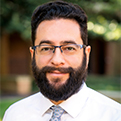Mapping the skies
Research & Innovation
Physics professor Jack Singal’s research aims to help provide a more complete view of the Universe, in part by studying the sky’s brightness in radio waves. That work will now have the support of a recently awarded $589,939 grant from the National Science Foundation.
Astronomers study radio waves, along with other kinds of light. Singal is working on a map that will be the first large-scale measurement of the actual absolute brightness level of diffuse radio emission in the Universe in more than 40 years.
Singal and his research partner, Richard Bradley of the National Radio Astronomy Observatory, will use the world’s largest steerable, clear aperture radio telescope, the Robert C. Byrd Green Bank Telescope in West Virginia.
“This project will use the defining features of the Green Bank Telescope, which is unique in the world, along with our custom radio receiver and feed antenna,” Singal said. “It is a beautiful marriage of a big facility and small-group research.”
They will use the telescope along with their instruments to create a map of radio emission over nearly the entire sky. The map will take several years to complete.
“It is a beautiful marriage of a big facility and small-group research.”

“Even though the observations we will do and the data we take will range over several years, nothing about the radio emission that we will be measuring changes over that time period,” Singal said.
While some places are vulnerable to radio interference, the Green Bank Telescope's location is not. In 1958, the Federal Communications Commission set up a Radio Free Quiet Zone in the area to protect the National Radio Astronomy Observatory as well as the U.S. Navy’s Information Operations Command at Sugar Grove from radio interference.
The radio sky brightness map is anticipated to be a transformative tool for investigating galactic and extragalactic phenomena.
“Almost the only way we really know anything about what is going on beyond Earth is by measuring and interpreting the light that comes to us,” he said. “In this case it is radio light.”

